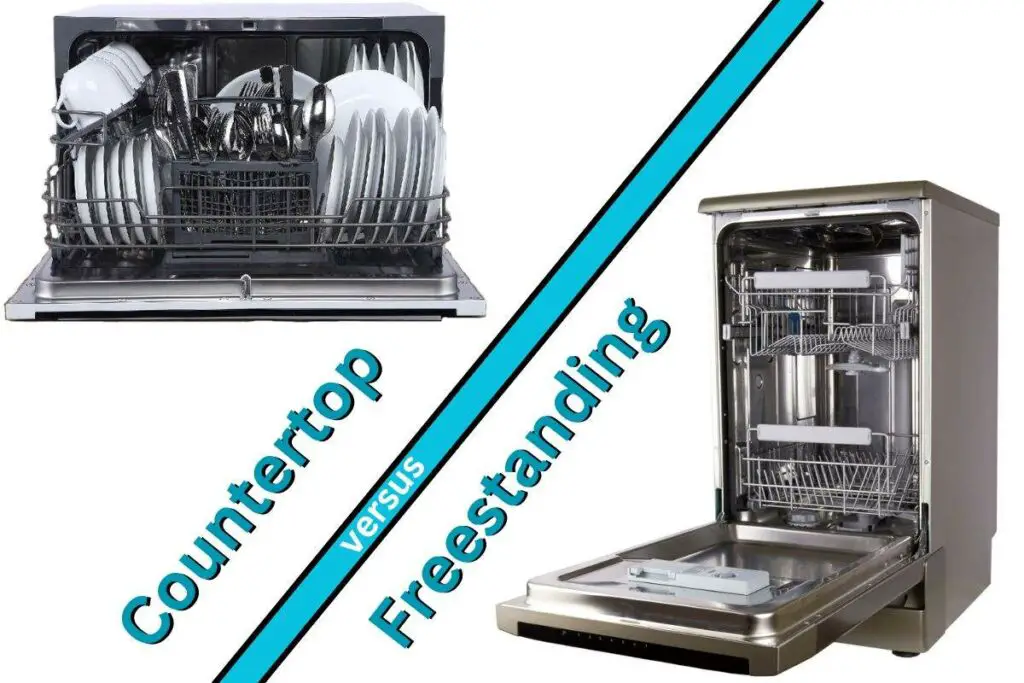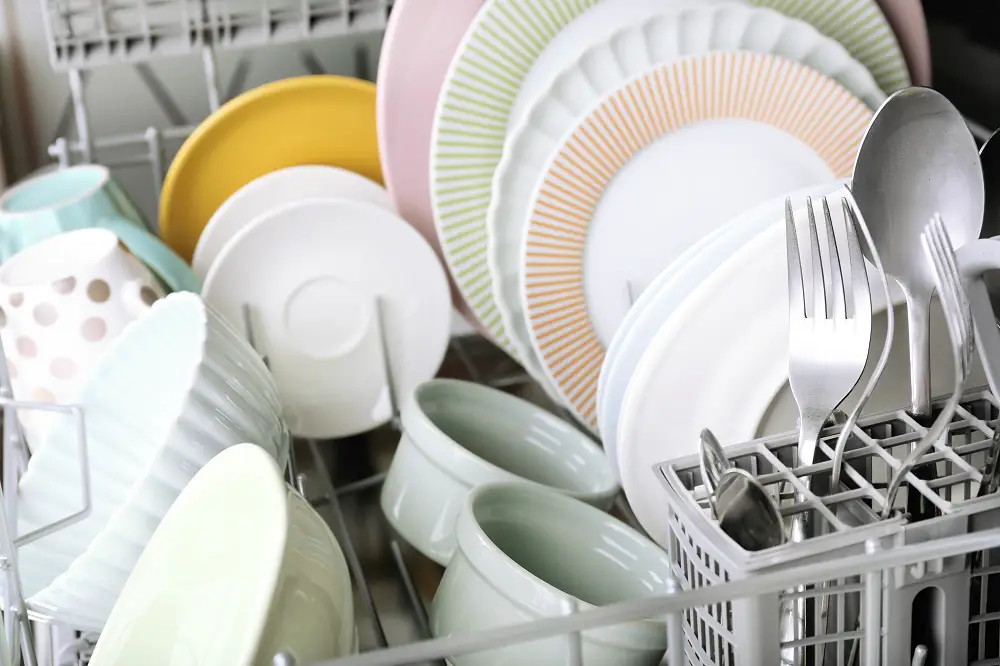Do you have a small kitchen, live in a rented space, or simply prefer a portable appliance? The two choices that can suit your needs are portable free-standing dishwashers and countertops. But what is the difference between a free-standing dishwasher and a countertop?
Portable freestanding dishwasher models come on wheels and are much like regular dishwashers. Countertops are placed on the kitchen counter and are usually much smaller than regular devices.
The two types of dishwashers differ in a few factors, including size, capacity, mobility, installation, and features.

Here’s all the information to help you understand the differences between portable freestanding dishwashers and countertop models to make an informed choice.
Table of Contents
Portable Freestanding or Countertop
When you don’t have sufficient kitchen space or the provision for a permanently installed dishwasher, portable dishwashers make an excellent choice. This is also the case if you’re renting a place and aren’t permitted to change out kitchen appliances.
This table summarizes the differences between freestanding and countertop dishwashers:
| Factor | Free-standing | Countertop |
|---|---|---|
| Size (width) | 18” or 24” | Within 22” |
| Capacity | 12-14 place settings | 4-6 place settings |
| Mobility | Yes | If required |
| Installation | Required with each use | Can be kept connected |
| Features | Mostly similar to built-ins | Limited features |
| Water Usage | ~ 3 gallons (11 liters) | ~ 2 gallons (7.5 liters) |
| Cost | $400 – $700 | $200 – $500 |
| Space Needed | Flexible | Fixed |
| Energy Usage | Similar to built-ins | Lower than free-standing |
| Conversion Capability | Can be converted to built-in | Can’t be converted |
Let’s look into more detail about the factors determining the differences or similarities between a freestanding portable dishwasher vs countertop.
Dimensions
Freestanding dishwashers
are a compact version of built-in dishwashers. The freestanding models come in the regular 24” width or slimline 18” width.
Countertop dishwashers
are smaller, typically within 22” in width, and are designed to sit on your kitchen counter.
Capacity
Freestanding dishwashers
have similar capacity as built-in dishwashers.
Usually, these portable models have 12-14 place settings and can hold pots, pans, dishes, glasses, and silverware. With multiple adjustable racks, you can accommodate plates of various sizes.
Countertop dishwashers
have a lower capacity when compared to freestanding models.

They’re suitable for washing smaller loads of dishes and can accommodate about 4-6 place settings.
Mobility
Although freestanding dishwashers
are heavier, they come with wheels and are easy to roll around between uses.
You can move a freestanding appliance and place it anywhere in your kitchen.
Countertop dishwashers
aren’t meant to be mobile and are usually placed on a fixed spot on the kitchen counter.
Although, since they’re lightweight, you can move them around for convenience if required. Especially if you’re tight on counter space and can’t keep the dishwasher next to the sink permanently.
Installation
A freestanding dishwasher
must be rolled it near the sink and set up the hoses for each use.
As for countertops,
they’re typically placed on the kitchen counter at a designated spot and are kept connected to the sink at all times.
You only need to load your dishes into your countertop dishwasher and start running a wash cycle.
Features
Freestanding models
offer a wide range of features and wash cycles, similar to built-in dishwashers.
The different wash cycle options include Normal, Heavy, Delicate, Quick, etc. Features like adjustable water temperature settings and specialized modes can also be found in freestanding models.
Countertop dishwashers
have comparatively fewer features and wash cycles when compared to freestanding dishwashers.
However, they still provide basic functions, water temperature settings, and options for drying dishes.
Water Consumption
Portable freestanding dishwashers
typically consume about 3-4 gallons of water, similar to built-in models.
This is because these portable devices have a similar capacity as built-in dishwashers.
Countertop dishwashers
are smaller and have reduced capacity, hence consuming much less water than freestanding models.
The typical water consumption of countertop models is about two gallons per load.
Some countertop models have a built-in water tank (of about 1.32 gallons capacity) and can be manually filled instead of connecting to a faucet.
You may also be interested in the real water usage of portable dishwashers with actual costs.
Cost
Since freestanding dishwashers
are similar to built-in models in many ways, their price range is also almost similar.
The portable freestanding models usually cost between $400-$700.
Countertop dishwashers
cost much less than freestanding owing to their reduced capacity. Typically, these models cost about $200-$500.
Do you think portables are expensive? Here is why.
Space Requirements
Freestanding dishwashers
don’t take up permanent space in your kitchen.
To use your portable appliance, you must place it next to the kitchen sink and hook up the connections. After you finish a wash cycle, you can roll the device away into storage or in a corner between uses.
Countertop dishwashers
take up kitchen counter space and are often permanently placed close to the kitchen sink for ease of connection.
Energy Consumption
Portable freestanding dishwashers
with an Energy Star certification consume about 1.2 – 2.4 kW per cycle on average.
Since countertop dishwashers
are smaller, they have a smaller motor and use only about 1 – 1.8 kW per cycle.
Conversion Capability
A freestanding appliance
can be converted into a built-in dishwasher with a conversion kit.
This is especially useful if you shift into a home with space and provision for an integrated dishwasher.
A countertop dishwasher
can also be converted into an under-the-counter appliance.
When To Buy A Free-Standing Dishwasher?
If you’re wondering when you should consider buying a freestanding dishwasher, here are some suitable situations:
- Limited Space
If you’re tight on floor space and don’t have the provision for a built-in dishwasher, a portable freestanding model is a viable option. Since it can be rolled into a corner when not in use, you can maximize your available space.
Additionally, if you’re extremely tight on counter space and can’t accommodate a countertop model, the next best option is a freestanding dishwasher.
- Increased Functionality
Freestanding dishwashers offer similar functions and features as built-in dishwashers. This includes multiple wash cycles and adjustable racks.
Unlike a built-in, you don’t have to permanently install a freestanding dishwasher, adding to its convenience.
- Too Many Dishes to Wash
Suppose you tend to accumulate loads of dishes because you cook your meals at home or frequently entertain guests.
In that case, the additional dishwashing capacity of a freestanding dishwasher (almost similar to a built-in capacity) is suitable.
Apart from the regular dishes, glasses, and cutlery, freestanding models can accommodate pots and pans that countertops can’t.
- Additional Counter Space
Butcher block top portable dishwashers are an excellent option if you require additional counter space for meal preparation or temporary storage.
You can conveniently roll your freestanding dishwasher near the edge of the kitchen counter and use it as an extension of the counter for your chores.
- Rental Home Restrictions
Property owners often restrict tenants from making any permanent modifications or additional fixtures.
Since freestanding dishwashers don’t require structural changes and can be connected and disconnected for each use, they’re a convenient option.
When To Buy A Countertop?
There are several situations when a countertop dishwasher might be a suitable solution. Consider the following points to determine if this type of portable dishwasher will be a good choice for you:
- Limited Space
If you have a small kitchen and are tight on floor space, a countertop dishwasher is a practical solution, provided you can dedicate the required counter space.
Countertops take up much less space than freestanding or built-in dishwashers and are an excellent option for apartments, dorms, and RVs.
- One or Two-Person Household
If you live alone or have two people in the household and fewer dishes to wash, a countertop dishwasher will help save time and effort.
- Budget
Since countertop dishwashers are more affordable than freestanding models, you can choose this cost-effective option if you’re on a limited budget or don’t want to invest in a larger appliance.
- Efficiency
Apart from the convenience countertop dishwashers offer to reduce manual labor, they’re also more efficient in water usage and time-saving.
If you’re looking for an economical option, consider countertop models.
- Temporary or Rental House
If you live in a rental space or move homes often, the portability and convenience of countertop dishwashers make them the best alternative.
Conclusion
Portable dishwashers – freestanding or countertops are a convenient option if you don’t have the space to install a built-in dishwasher.
However, the two types of portable dishwashers vary with regard to a few factors.
Freestanding vs countertop differences include size, capacity, energy and water consumption, mobility, installation, features, and cost.
Once you know the conditions for which each type of dishwasher is suitable, you can make an informed choice and buy the kind that is most convenient.



